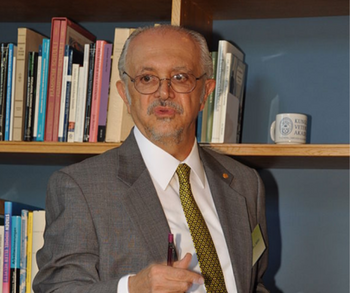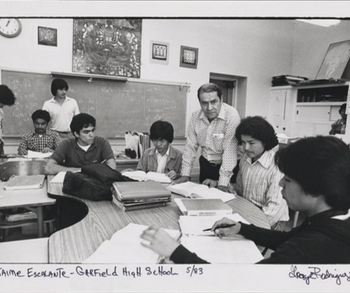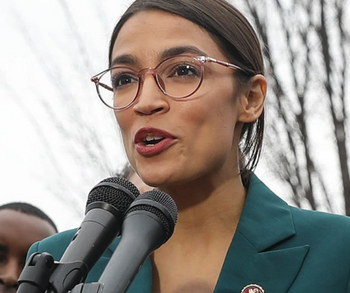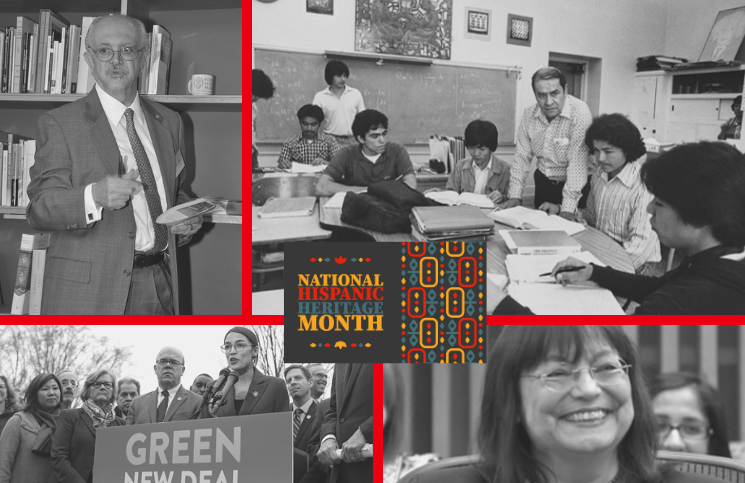by Joan Reissman
Continuing JFY’s salute to Hispanic Americans’ contributions to the country and the world
Mario Molina 1943-- 2020

Have you ever given much thought to the ozone layer? Do you think it’s important? Mario Molina, a Nobel prize-winning scientist, dedicated much of his scientific research to the ozone layer and its importance and how we can preserve it. He understood that discoveries made in the lab can have profound implications for society, and how such knowledge can be used to help preserve the planet.
Mario Molina was born in Mexico City in 1943. Mario did not have the typical interests of a young child. He developed an interest in chemistry and his family allowed him to convert a spare bathroom into a chemistry lab when he was nine years old.
Although he already had an advanced degree from the University of Freiberg, Molina moved to the United States to study at the University of California, Berkeley and received his PhD in physical chemistry in 1972. The sixties were a turbulent time for colleges, and Berkeley was the epicenter of student activism. Molina said of the Berkeley atmosphere “…during this time …I had my first experience dealing with the impact of science and technology on society… I wanted to be involved with research that was useful to society, but not for potentially harmful purposes.”
Molina joined F. Sherwood Roland for post-doctoral research at the University of California, Irvine. Molina and Roland were one of the first research teams to produce a paper that connected CFCs ( chlorofluorocarbons) with the deterioration of the ozone layer. Why is this important? At that time CFCs were widely used in cooling and aerosols. CFCs are released into the atmosphere and decompose. Rowland and Molina discovered that after decomposition, the chlorine atoms were destroying the ozone layer. Why does this matter? Because the ozone layer protects the planet from UV radiation. UV radiation can cause skin cancer, harm crop production by reducing photosynthesis, and endanger marine life by destroying phytoplankton, the base of the marine food chain).
When Rowland and Molina published their research, this information was not something corporations wanted to hear. CFCs were efficient for aerosol propulsion and coolant. Rowland and Molina publicized their findings so that politicians and policy makers understood the implications of their research and would be motivated to regulate CFC usage.
Although the research was attacked by industry representatives, these findings eventually led to an environmental treaty, the Montreal Protocol of 1987. Rowland, Molina and the Dutch chemist Paul Crutzen, whose work coincided with theirs, were awarded the Nobel Prize for Chemistry in 1995. Molina used the money to continue researching. Environmentalists still cite Mario Molina for his important contributions. Al Gore (who also won a Noble Prize for his environmental work) said that Dr. Molina “never backed down from political pressure, always speaking truth to power, grounded in science and reason.” The world,” Gore added, “is a better place because of Mario.”
Image source: Mario Molina, at the Nobel Laurate Globalsymposium 2011, at Vetenskapsakademien in Stockholm, discussing climate change. Creative Commons Attribution-Share Alike 3.0. Author: Janwikifoto
Lydia Villa-Komoroff 1947 –

As many as 200 million people worldwide need insulin to manage their diabetes. Managing diabetes became much easier thanks to the contributions of Dr. Lydia Villa-Komoroff.
Dr. Villa-Komoroff always knew she wanted to be a scientist, even though she faced gender barriers along the way. She persevered and made many important contributions. In addition to her significant scientific contributions, Dr. Villa-Komoroff is also an advocate for students pursuing STEM careers.
Her message is that STEM careers are for everyone: race and gender should not be allowed to stand in the way.
Lydia Villa-Komoroff was born in New Mexico in 1947. By age nine, she knew that she wanted to be a scientist. In 1965, she enrolled in the University of Washington. At first, she chose to major in Chemistry because her uncle, a chemist, had encouraged her to pursue a career in science. When she asked an advisor for help because she was having trouble with an assignment, he said, “Of course you’re having trouble in chemistry. Women don’t belong in chemistry.”
After that sage advice, Villa-Komoroff switched her major to biology. In 1967 she moved with her future husband to Washington D.C. Although she applied to Johns Hopkins, the university was not accepting women at that time. (Women were not admitted until 1970.) Villa-Komoroff went to Goucher instead. After graduating with a biology degree, she moved to Cambridge and received her PhD in molecular biology from MIT in 1975. She was the third Mexican American woman to earn a scientific PhD in the United States.
Dr. Villa-Komoroff’s research continued with post-doctoral work at Harvard University. The first method of obtaining insulin was to use the pancreas of a pig or cow. This was a difficult process, and insulin was often in short supply. Lydia joined the Gilbert lab at Harvard and worked with a team that cloned the insulin gene. Her pioneering research was published in the paper “A Bacterial Clone Synthesizing Proinsulin.” The Gilbert team had to move their research lab for a year because the City of Cambridge banned experiments with recombinant DNA technology. After a series of failures in Cold Spring Harbor, the team returned when the ban was lifted. The Gilbert team was eventually able to clone a double stranded DNA to make insulin. The ability to produce insulin from bacteria was a big breakthrough because it was easy to manufacture, making insulin cheaper and therefore widely available.
Lydia was not just interested in science—she was also an activist. While in graduate school in 1973 she became a founding member of the Society for the Advancement of Chicanos/Hispanics and Native Americans in Science (SACNAS). Dr. Villa-Komoroff continued her interest in lowering barriers for people of color. She is now focusing on “presenting from a natural scientist’s point of view what implicit bias is…. Perception can result in unintended bias. We develop associative illusions based on our culture. The mind makes up short cuts, and inappropriate associations can result,” she has explained.
Lydia Villa-Komoroff is a brilliant scientist and a true role model for girls who are interested in science.
Image source: Photo of Dr. Lydia Villa-Komaroff, 12 June 2017, 09:03:42, Author: Anthony L. Komaroff
This file is licensed under the Creative Commons Attribution-Share Alike 4.0 International license.
Jaime Escalante 1930-2010

Could a class of inner-city Black and Hispanic math students pass an AP Calculus exam? The documented record of attempts said no. One math teacher said yes.
The movie Stand and Deliver (1988) tells the story of this teacher. His name was Jaime Escalante and he taught high school math in Los Angles.
Jaime Escalante was born in Bolivia. He was raised by schoolteachers, so it seemed natural that he would also become a teacher. By the time Escalante graduated from the Normal Superior Teachers’ College, he was teaching at three Bolivian schools. Escalante and his family decided to move to the U.S. for greater opportunities. The family arrived with very little money and very limited English.
At first Escalante made a living by mopping floors. He worked during the day and studied math and physics at night. He got a better job as a technician, but he missed the classroom. He went back to school to earn a teaching degree and took a job at Garfield High School in Los Angeles in 1974.
Escalante was dismayed when he saw the low level of math and the low expectations at Garfield. He felt the high school curriculum matched 5th grade math in a Bolivian school. He grew discouraged because he felt that the students were not interested in learning.
With the support of his principal, Escalante started an AP Calculus class in 1978. His first class was not a great success. Fourteen students signed up but only two passed the AP exam. Escalante did not give up. Year by year, passing rates improved and by 1981, 14 out of 15 passed the exam.
In 1982, 18 students enrolled in Escalante’s AP math class. Escalante was a tough teacher. He motivated his students with a combination of demanding requirements and entertainment. Students had to study before and after school and on Saturdays. He adopted the role of rebel, loved by students but often disliked and resented by colleagues. Escalante’s students became very attached to him. They even gave him a nickname: Kimo.
Escalante was tough and dedicated. He was hospitalized twice during the school year but he kept on teaching. He had a heart attack. Ever the rebel, he ignored the advice of his doctors and came back to school the next day.
Escalante and his students were rewarded for their hard work. In 1982 all 18 of his Calculus students passed the AP exam and 7 received the highest score of 5. But prejudice reared its ugly head. Escalante’s students were accused of cheating by the Educational Testing Service. The agency invalidated 14 of the 18 scores on the grounds of “suspicious similarities.” Students were very angry. Garfield had almost lost its accreditation and many of the students were from low-income neighborhoods. They felt that ETS would not have accused them if they were white. ETS made 14 students with invalidated scores retest. Escalante’s students proved that ETS was wrong: 12 out of the 14 re-testers passed again.
This success brought about dramatic change for Garfield High. Students gained confidence and many signed up for AP courses. Garfield became one of the top high schools for AP Calculus.
Escalante had very high expectations, but he was also a great entertainer. He used all kinds of props (basketballs, windup toys, etc.) to hold his students’ attention. He became a model of how to motivate difficult students and educators came from all over the country to observe him.
Escalante tried to replicate his success at another school in Sacramento, but he could not build a good program. He said he didn’t have the level of administrative support he needed. After 35 years in the United States, Escalante and his wife packed up and returned to Bolivia in 2001.
Later, Escalante supported many causes. Some were unpopular with his former supporters, such as his opposition to bilingual education. The last time he returned to the US it was for cancer treatment in 2008. He was so sick he could barely walk or speak. Although he was often disliked by his colleagues and received few teaching awards, nobody can deny his success and his continuing inspiration to teachers and students.
Image: Lin-Manuel Miranda in the title role of his musical “Hamilton”, April 20, 2016, Date Taken: 20 April 2016, 16:50:21
Source: This image was originally posted to Flickr. Its license was verified as “cc-by-2.0” by the UploadWizard Extension at the time it was transferred to Commons. See the license information for further details
Alexandria Ocasio-Cortez 1989 --

Love her or hate her, Alexandria Ocasio-Cortez has become one of the leading voices of progressive Democrats. She is never afraid to express her opinion and give her support to causes and legislation she believes in.
Ocasio-Cortez gained national attention when she defeated 10-term incumbent Joe Crowley in her Congressional district.
That doesn’t prevent her from endorsing incumbents who support causes she believes in. In Massachusetts, she endorsed Senator Ed Markey in the 2020 primary against Rep. Joe Kennedy III. She made a TV ad with Markey in which she addressed the camera directly saying, “When it comes to progressive leadership, it’s not your age that counts. It’s the age of your ideas. And Ed Markey is the leader we need.”
What was Ocasio-Cortez’s journey to becoming the youngest member of Congress ever elected? AOC was born in the Bronx but her family later moved to the suburbs. She attended Boston University and majored in international relations and economics. After graduating cum laude in 2011, she became involved in politics. After her work with the Bernie Sanders 2016 primary campaign, a visit to Flint, Michigan, and Standing Rock reservation, AOC decided she wanted to become a Congresswoman.
Few thought she had a chance when she ran in 2018, but she campaigned hard. Congressman Joe Crowley had been the district’s representative since 1999. He was fourth in seniority in the House and a leading potential successor to Speaker Pelosi. He spent $1.5 million on the primary to her $300,000. AOC used community involvement and social media to attract voters. And she succeeded. She won 57% of the vote.
Her enemies slam her as a crazy left-wing bartender, but she has put forth several significant resolutions and pieces of legislation. Her most notable resolution was the Green New Deal, co-sponsored with Senator Ed Markey. The goal of the Green New Deal is to increase investment in renewable energy to lower greenhouse gas emissions and create new jobs. Although the resolution had dozens of co-sponsors in the House, it failed to pass the Senate.
What are AOC’s other accomplishments? In her first two years she co-sponsored 78 bills of which 14 became law. AOC’s progressive district gives her rhetorical room to express her views with little restraint. She is a visible and vocal leader of the Squad, a prominent group of progressive young representatives that includes Ilhan Omar, Ayanna Presley, Rashida Tlaib, Jamaal Bowman and Cori Bush. The Squad’s outspoken support of progressive causes has made them a target of vicious right-wing social and broadcast media, but no amount of airborne flack is going to slow them down. Whatever you may think of AOC, with her hoop earrings she has become the most recognizable face of progressive reform.
Image source: Senate Democrats, 7 February 2019 https://www.flickr.com/photos/.
Representative Alexandria Ocasio-Cortez speaks on the Green New Deal with Senator Ed Markey in front of the Capitol Building.
This file is licensed under the Creative Commons Attribution 2.0 Generic license.
This post is the second installment of JFY’s salute to Hispanic Americans.
Si se puede defines the determination of the people profiled in this and the preceding article. These Hispanic American heroes pursued their goals and overcame many obstacles.
- César Chávez dedicated his life to helping migrant farmworkers.
- Sonia Sotomayor became the first Hispanic American to be appointed to the highest court in the US.
- Lin-Manuel Miranda created one of the most successful musicals in Broadway history.
- Julia Alvarez gave voice to the Hispanic American cultural divide in American literature.
- Lydia Villa-Komoroff made a key discovery for diabetics and continues to advocate for women of color in STEM careers.
- Mario Molina’s research brought awareness and legislation to protect our planet.
- Jaime Escalante refused to let prejudicial stereotypes limit what students could achieve.
- Alexandria Ocasio-Cortez has established herself as a leading advocate for progressive causes.
All these individuals have made lasting contributions to the country and the world. We are grateful for their work as we take this dedicated time to celebrate their achievements.
Si se puede!
Joan Reissman is a JFYNetWorks learning specialist.
Other posts authored by Joan can be found here.
HOW ARE WE DOING? In our pursuit to serve up content that matters to you, we ask that you take a couple of minutes to let us know how we’re doing? Please click here to be navigated to our JFYNet Satisfaction Survey. Thank you!





